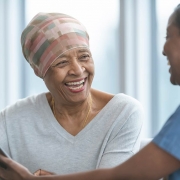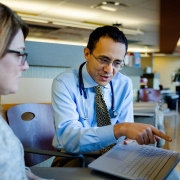Breast Cancer in Men: Recognizing Symptoms, Reducing Risk
Breast cancer is most often associated with women, which is understandable as more than 276,000 women are expected to be diagnosed in 2020. Yet, breast cancer occurs in 1 of every 83 men and carries a 5% mortality rate.
Consequently, men need to be vigilant and educated about the symptoms and signs of breast cancer and should feel comfortable discussing them with their physician.
Symptoms of Male Breast Cancer
The clinical features of breast cancer in men are no different than they are in women. Symptoms include a lump or thickening in or near the breast or underneath an arm. A dimpling or puckering of the skin—known as peau d’orange—can also be a symptom, particularly of inflammatory breast cancer, and the nipple of the breast may be inverted. Another thing to look for is nipple secretion, which can be especially concerning if the drainage is blood.
No one is immune to cancer, but there are some factors that can heighten the risk of breast cancer in men, including exposure to radiation and a history of breast cancer in their family. An increase in a man’s estrogen level can also heighten the chances of breast cancer, so conditions such as Klinefelter’s syndrome and cirrhosis are risk factors. Transgender men using estrogen injections are also at an increased risk.
Self-Examination and Treatment
Like women, men should do routine self-examinations and check for thickening or lumps in the breasts. The best screening is a simple palpating of the tissue and checking in a mirror for any changes in the look of the breast’s skin or nipple. This should be done once a month, especially for men with a family history of cancer.
If any irregularities are noticed, reach out to a physician immediately. In the event of a tumor, the procedure for men is the same as women – a biopsy followed by a diagnosis, and then the decision whether to do surgery with or without chemotherapy or radiation therapy.
One of the biggest differences regarding breast cancer treatment in men and women is endocrine therapy. Aromatase inhibitors, which stop estrogen production in postmenopausal women, are used to treat women whereas men are typically treated with tamoxifen, which blocks the effects of estrogen in breast tissue. The reason for the difference is the insufficient amount of data supporting use of aromatase inhibitors to treat male breast cancer.
Erasing the Stigma
Cancer takes an emotional and mental toll on anyone it strikes. But because breast cancer is so strongly associated with women, men often face additional psychological challenges.
Some may feel their manhood is in question once they hear the diagnosis or they may become embarrassed by it. While stigmas are real and can be debilitating, the reality is that male and female breasts are made of the same tissue.
Consequently, psychological care is a big component of treating breast cancer in men, especially for patients with estrogen-receptor-positive cancer—the most common form of breast cancer wherein estrogen receptors on the surface of the cell bind to estrogen and enable the cancer to grow. In men, this means they are creating more estrogen than progesterone, which can make them feel like less of a man. Therefore, taking extra time to address stigma is an extremely important element of care.
Scarring is another concern. Reconstructive plastic surgery isn’t offered for men who undergo surgery to treat breast cancer, so it is important to remind male patients that the scar does not make them less of a person. In fact, the scar should be looked at as a symbol of the surgery that may have saved their life.
Resources for Men
In tandem with the multitude of female-driven support systems in place for women, such as the saturation of pink every October to mark Breast Cancer Awareness Month, there are also good resources for men battling breast cancer.
The Male Breast Cancer Coalition and the Young Survival Coalition are helpful resources offering information about male breast cancer, as well as hotlines and support groups.
It is important to remember that cancer can happen to anyone – and while breast cancer in men is rare, it is real and can be deadly. As providers and oncologists, it is important that we recognize the physical and mental components of working with male breast cancer patients and provide the support systems that deliver optimal care outcomes.














